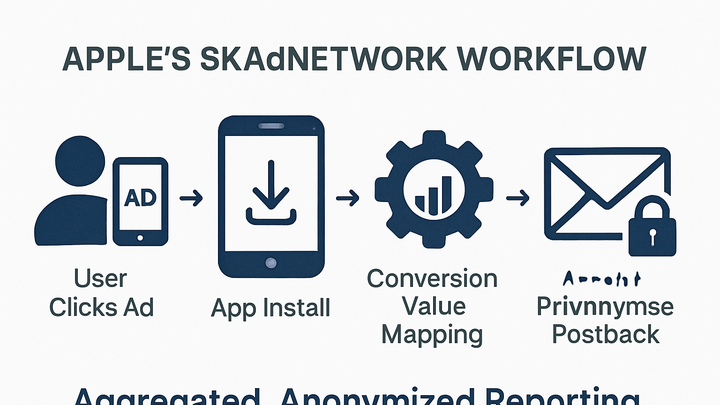Published on 2025-06-28T07:59:38Z
What is SKAdNetwork? Examples for SKAdNetwork
SKAdNetwork is Apple’s privacy-centric framework for measuring app install attributions from advertising campaigns without exposing user-level identifiers. Launched with iOS 14.5, it replaces reliance on the Identifier for Advertisers (IDFA) by providing aggregated, anonymized postback data. The framework uses a 6-bit ‘conversion value’ to signal key in-app events, enabling marketers to gauge campaign effectiveness while respecting user privacy and App Tracking Transparency (ATT) guidelines. SKAdNetwork notifies ad networks of installs and conversion updates through delayed postbacks, with timing and thresholds designed to prevent fingerprinting. Analytics platforms such as Google Analytics 4 (GA4) and PlainSignal integrate these postbacks to offer insights into campaign performance in a cookie-free environment. By balancing measurement needs with privacy safeguards, SKAdNetwork sets a new standard for mobile ad attribution.
Skadnetwork
Apple's privacy-first ad attribution framework using aggregated postbacks and conversion values for iOS campaign measurement.
Why SKAdNetwork Matters
SKAdNetwork fundamentally shifts how advertisers measure iOS campaign performance by prioritizing user privacy. It complies with Apple’s App Tracking Transparency (ATT) requirements and eliminates dependency on the IDFA. This framework ensures marketers still receive essential install and conversion metrics without accessing granular user data. Understanding its importance is critical for adapting analytics strategies and maintaining compliance with evolving privacy regulations.
-
Privacy-first attribution
SKAdNetwork delivers install and conversion data in an aggregated, anonymized fashion, safeguarding individual user identities.
-
No idfa required
Ad attribution no longer relies on the IDFA, preventing cross-app user tracking.
-
Att compliance
Works seamlessly with Apple’s App Tracking Transparency, respecting user opt-in preferences.
-
-
Continued campaign insights
Despite privacy constraints, SKAdNetwork provides key performance indicators like installs and in-app conversions.
-
Conversion value
A 6-bit field represents up to 64 post-install event combinations.
-
Postback timing
Delayed reporting maintains privacy, with configurable windows for conversion updates.
-
-
Impact on analytics tools
Analytics platforms must adapt to SKAdNetwork’s aggregated signals, updating how data is collected and reported.
-
GA4 integration
Google Analytics 4 imports SKAdNetwork postbacks to attribute installs without cookies.
-
PlainSignal support
PlainSignal’s cookie-free analytics can ingest SKAdNetwork data for unified dashboards.
-
How SKAdNetwork Works
SKAdNetwork uses a sequence of ad click registration, app install detection, conversion value assignment, and delayed postback delivery to attribute installs in a privacy-preserving manner. Below is a breakdown of each stage in the attribution flow.
-
Ad interaction
When a user clicks or views an ad, the ad network registers the interaction with SKAdNetwork.
-
Network registration
The ad network records campaign identifiers before handing off to the App Store.
-
Campaign id
Identifies which ad campaign to credit upon installation.
-
-
Install and conversion value assignment
Upon first app launch, the app notifies SKAdNetwork of the install and sets a conversion value based on user actions.
-
First-open measurement
SKAdNetwork detects the initial app open event to attribute the install.
-
Conversion value mapping
Developers map in-app events to a 0–63 scale to capture user engagement post-install.
-
-
Postback delivery
SKAdNetwork sends a delayed, privacy-safe postback to the ad network indicating the conversion value and attribution.
-
Privacy thresholds
Apple enforces minimum install counts and delays to prevent user fingerprinting.
-
Single postback
Each install triggers one final postback, preventing repeated data exposure.
-
Implementation Best Practices
Implementing SKAdNetwork correctly ensures reliable attribution and maximizes data quality. The following best practices outline key steps for developers and marketers.
-
Configuring conversion values
Define and prioritize in-app events that align with business goals, using bitwise operations to optimize the 6-bit conversion value.
-
Event prioritization
Map high-value actions (e.g., purchases) to higher bits to capture critical events.
-
Timely updates
Update conversion values strategically within the allowed time window to reflect user behavior accurately.
-
-
Monitoring with GA4
Use Google Analytics 4’s SKAdNetwork reports to analyze install trends, configure custom dimensions, and build funnels.
-
Skadnetwork reports
Enable and review the dedicated SKAdNetwork dashboard within GA4 for aggregated metrics.
-
Custom funnels
Leverage funnels in GA4 to visualize user progression based on conversion value data.
-
-
Using PlainSignal tracking code
To collect SKAdNetwork postbacks and website analytics with PlainSignal, embed the following snippet on your pages:
<link rel="preconnect" href="//eu.plainsignal.com/" crossorigin /> <script defer data-do="yourwebsitedomain.com" data-id="0GQV1xmtzQQ" data-api="//eu.plainsignal.com" src="//cdn.plainsignal.com/plainsignal-min.js"></script>-
Domain authorization
Ensure your app and web domains are registered and authorized in your Apple developer account.
-
Placement best practice
Place the script within the <head> section for optimal load and accurate event capture.
-
Limitations and Considerations
While SKAdNetwork preserves privacy, it introduces certain limitations in data granularity, timing, and volume thresholds that marketers should understand to set realistic expectations.
-
Data granularity constraints
Conversion values are limited to a 6-bit integer, restricting the number of unique events or revenue brackets that can be tracked.
-
Binary mapping
Developers must encode multiple events into a single value, which can obscure nuanced behaviors.
-
Single conversion value
Only one conversion value can be reported per install, preventing sequential event tracking.
-
-
Reporting delays
Postbacks are delayed by a randomized timer between 24 to 48 hours to protect user privacy, impacting real-time analysis.
-
Uncertain timing
The variability in delay can complicate time-sensitive optimization decisions.
-
No live debugging
Real-time troubleshooting of SKAdNetwork flows is limited by the delayed nature of postbacks.
-
-
Privacy threshold effects
Apple applies minimum install volume thresholds for postbacks to be delivered, which may omit data from low-volume campaigns.
-
Aggregate reporting
Campaigns below threshold may not generate postbacks, skewing performance data.
-
No user-level debug
Apple does not provide identifiable data, complicating granular error diagnosis.
-
